#writing isn't my style but I wanted to provide more context to the images
Explore tagged Tumblr posts
Text
Gummies, a short comic
(I’m no writer so bear with me)
Nika is acting strange
grabbing hold of the mechanic’s hand
Chuchu takes Nika to the Earth House dorms to see what’s up

Once standing now her back suddenly against the floor
Chuchu realized


she was the bottom of this relationship
Woah…Nika…
She’s on top of her
uniform unzipped
Where did the tie go?
The mechanic was leaning closer
she’s so…wobbly…ah…she fell over
Nika was now lying beside her making grunting noises
What’s gotten into her?! This isn’t like her at all…
“Nika-nee…”
Wait, what is that?

What the hell?
Gummies?
Is this what’s causing her to act so strangely?
Where did she even get these?!
Chuchu glanced over at Nika
She’s sitting now
and…chewing something..!!
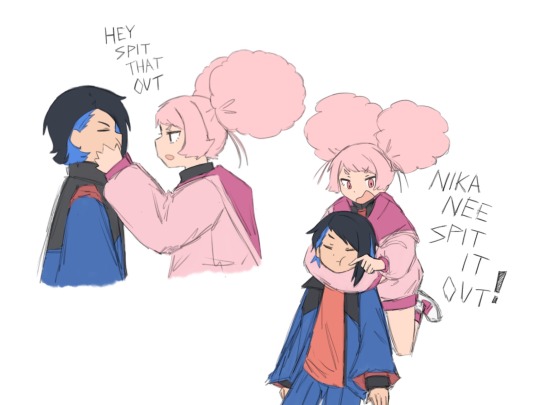
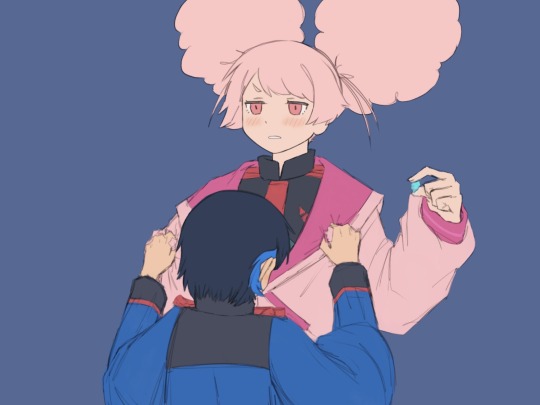
She got it out
Nika on the other hand was now clenching Chuchu’s jacket tightly
She would NOT let go
Damn it Nika…
The mechanic brought the jacket down to Pom-Pom’s feet and pulled
Chuchu reluctantly stepped out of it as Nika kept pulling
The mechanic fell back, jacket in her grasp
Ah…she took my jacket…
Chuchu raised a hand to reach out towards Nika to give it back
but she was hugging it dearly
no clear sign of giving it up
Chuchu blushed
Cute…
She turned around, scratching the back of her neck
Well, it can’t be helped..
She looked back at Nika who was rubbing her face all over her pink jacket
Nika…
Chuchu walked over to her mechanic
squatting down, arms over her knees
Nika fell over to her side, giggling with the jacket in her face
Chuchu chuckled,
“You’re so drunk, Nika-nee.”
This wasn’t the time to play around though
even Chuchu knew that
She placed her hands under Nika and lifted her up
carrying her in her arms
Yeah she can carry her
Nika was taller but it wasn’t going to stop Chuatury Panlunch
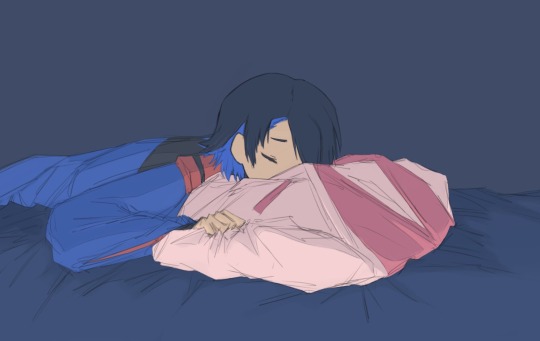

Chuchu had notified the other Earthian girls via text to come to the dorms
She explained the situation and handed the near-empty bag of gummies to Aliya
Lilique placed her hands on her knees and looked down at a now sleeping Nika
She was worried
Nika wasn’t looking too good
The three knew they couldn’t take Nika to the nurse’s office
They would get in so much trouble for having these kind of gummies on campus
knowing they wouldn’t even get a chance to explain because they’re Earthians
then again
How did Nika even get these? There’s no way she’d eat these if she knew what was actually in them
Did she not notice the taste? Well, Chuchu didn’t know how they tasted like
For all she knows they could taste the same as regular gummies or even better!
Someone must have given these to Nika, saying they were just normal fruity gummies
Chuchu was going to get to the bottom of this
but for now
she’s going to stay by Nika’s side and look after her
Bonus:
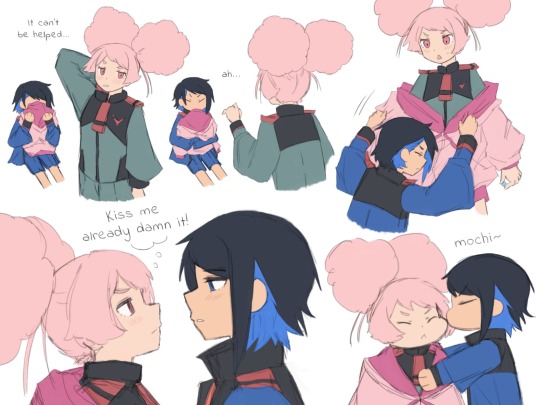
#wow I finished this at 6 am#writing isn't my style but I wanted to provide more context to the images#idk if I’ll continue this but yeahhh#Nika is going to have a big tummyache and headache when she wakes up#but she’ll be okay bc Chuchu is there#and Aliya will provide remedies#this was all an excuse to draw a drunk Nika#which I want to explore more on if I continue this#her drunken state is supposed to reflect on her how she feels about being a go-between and having to endure the torment from the Spacians#bottled up emotions leaking out#that obviously wasn’t shown here but I have ideas#her love for Chuchu spilled out more#wanting to hold onto what she holds dear to her from the fear of losing them because she’s lying to them#nikachu#chunika#nika nanaura#chuatury panlunch#chuchu#gundam witch from mercury#g witch#my art
74 notes
·
View notes
Text
Maycomb Blume and "Reading" Loveless in Rebirth
Heya, folks. SPOILERS ahead for Rebirth. Loveless is the only thing that should be spoiled, but I do mention foreshadowing for another event without stating the event.
Content Warning: Death is mentioned, and there is an image of a skull being held by David Tenant. This should be the only time I have to provide a David Tennant warning on this blog /s.
I've let this blog go dormant since I started it and emptied it out, but I wanted to use it. Originally, I started this blog to chronicle my readings of FF7, FF8, and FF9 as adaptations of Xiyouji, but that didn't feel like an easy thing to start with.
I did have the first section of a close reading of Loveless as it appears in English posted here, but I wanted to restart with pointing out how "reading" video games more deeply can be rewarding and is something you probably already have the tools to do if you went to primary school in the past 30 or so years. I will throw the close reading back on here when I've edited it, but I want to be doing something with this blog that isn't quite so deeply analytical to start. I also like adding images to break up text, and this is one of the few places I can do that with alt text for accessibility. Tumblr doesn't like outside links, though, so win some, lose some.
I wanna focus on Loveless from Rebirth with one critical lens among many that you can use to find your own meaning from it. You can even use weaker lenses, like the monomyth and its mother goddess guiding a hero or a Wagnerian reading, if you want. Loveless is a story about heroes on the stage set to music, even if it doesn't neatly line up with either lens. One could display how it resists interpretation by those lenses, for example. In any case,
You Probably Already Know About Literature
Loveless is a play. Even being in a game, it is a play that bears features common to European and American plays and operas from the 16th Century to the modern day. While some parts may be foreign to what you were taught in school, like the operatic portion at the beginning and the lead-solo at the end, the three-to-five act structure with exposition, rising action, climax, and falling action is something quite common to primary education in a lot of countries.
If you were taught this in primary school, you were probably also taught it through a few key authors, artists, directors, and playwrights. If you're from the US, those names likely included some people like James Baldwin, Harper Lee, Kurt Vonnegut, and maybe a few authors from South America like Julio Cortázar or Laura Esquivel. Without doubt, though, I bet you had to read Shakespeare.
That isn't without good reason. Regardless of what you think about him or his works, Shakespeare's words have been enjoyed and remade countless times around the world in many languages. His dominance of theater of a European style is to the point that some of his lines in isolation, ripped of their context, are enough to call to mind the drama on stage to much of the world.
If I say "To be or not to be..." most native English speakers are already finishing the line or jumping ahead to picture a skull in hand, dramatically lamenting a fellow of infinite jest who now has none who would mock his grin. I've seen the same happen with "Ser o no ser..." and "Sein oder Nichtsein..." in non-literary conversations.

David Tennant not mocking Yorick's grin as Hamlet. Image retrieved from Yorick on Wikipedia, originally from BBC article Bequeathed skull stars in Hamlet.
But, that aside, a piece of Loveless begins before the play, somewhat like the earlier events of Hamlet reflecting in his own play within a play.
You Probably Already Know How to Find Out More About Literature.
If you went to school in the age of the internet, you probably had to do research online to back up your writing in an essay on some piece of media you might not have cared about. Maybe you just found a website, reputable or not, that made an argument you could pull a quote from and stick in your writing. Hopefully, though, there was at least a time or two where you genuinely connected with a piece of assigned media and wanted to see what you could find from scholars about the plot, symbols, style, etc. to inform and elaborate on your own thoughts. I want to do that second one with Aerith's pseudonym for the solo at the end of Loveless, Maycomb Blume.
If you put "Maycomb Blume" into a search engine, I'm using Google through a VPN on a clean device, you're probably going to see a wall of FF7-related pages discussing the name. Unfortunately, those aren't the best sources for doing more than stimulating reflection on your own ideas. Most of them seem to come to a homophonic conclusion that it sounds like "make em bloom" that first appeared on a fan Twitter account. However, you might see an article or two about a book by Harper Lee set in the fictional town of Maycomb, Alabama - To Kill a Mockingbird.
If you look into them, you'll see that they tend to be reflecting on the resistance, or lack thereof, to oppression present in the novel by its protagonists. At first, that may seem tenuous, but let's follow the string and look into the Maycomb part of Maycomb Blume. A large piece of Final Fantasy VII is resistance or lack of resistance to oppression bringing characters together or pushing them apart, after all.
If you look up 'Maycomb' by itself, you will quickly find that it almost exclusively refers to the fictional town of Maycomb invented by Harper Lee. Google Ngram Viewer confirms this, showing virtually zero mentions of 'Maycomb' until the release of To Kill a Mockingbird. As a deliberate choice of translation, they sure did pick a unique word, no? But what about the "Blume" part? That isn't exactly an uncommon word, and it has myriad variations.
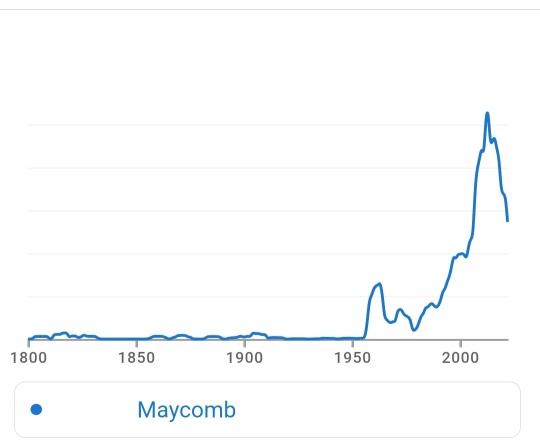
The results of a Google Ngram Viewer search for Maycomb, showing the sudden increase in the appearance of the word Maycomb in text after Lee's publication. Image screenshot from Google Ngram Viewer on October 19, 2024.
If you keep digging and do more looking, you might find that one of the most famous, influential, and controversial literary critics, Shakespeare scholars, and Harry Potter-haters in the world, Harold Bloom, was the editor for an anthology of critical essays on To Kill a Mockingbird. If you know anything about him, you might be aware of his idea that all works of literature are essentially "remakes" that carry influence from the ideas and stories they are latecomers to. This idea is what he called the anxiety of influence.

Harold Bloom, the man who hated Harry Potter before it was cool. Image retrieved from Wikipedia, by Bernard Gotfryd and originally obtained from the page Bernard Gotfryd on the Library of Congress website.
So what did Bloom have to say about Lee's most famous work in this text? Not much, as he was the editor of the volume, but he did say that the protagonists weren't what one would call heroes, but reflections of a sensibility that saw itself without the need to change in the face of racism:
The crises of [Scout’s] book confirm her in her intrinsic strength and goodness, without wounding her sensibility or modifying her view of reality.
So, where our initial look might lead us to a simple homophonic "it sounds like 'make em bloom,'" our deeper look leaves us with a lens from a scholar most focused on works of poetry on the stage, the anxiety of influence, and a theme with which to use that lens with, growth of a protagonist in the face of oppression. These tools seem appropriate for a work that is explicitly part of a "remake" of an earlier work that deals heavily with oppression, how people do or do not resist it, and what that leads them to do - so how well do they apply to Loveless?
You Probably Know How to Apply This to Loveless
Again, if you went to primary school in an English-speaking country in the past 30 years, you were probably taught the basics of how to apply critical lenses to any media you consume. If you had to read A Modest Proposal and discuss how well Jonathan Swift satirizes the plight of the poor in Ireland and upper-class reactions to it, you were being exposed to rudimentary Class or Marxist Criticism. In the US, you might have also been exposed to it while reading The Great Gatsby or The Grapes of Wrath. If you had to analyze the symbols in an Edgar Allan Poe work and explain the ideas, sensations, emotions, and images they called up for you and how well they served the work as they were written, you were being exposed to rudimentary New Criticism. In the US, you might have also been exposed to it while reading Song of Myself or listening to I Have a Dream.

Edward Manet's interpretation of the visit of the raven, both chaotic and clear. Image retrieved from The Raven on Wikipedia, originally on the Library of Congress website linked by a dead link.
The anxiety of influence, or Bloomian criticism, is just like those lenses in that it is a tool for you to apply as an individual reader. Primary schools don't often use even rudimentary Bloomian criticism, though, because it requires a knowledge of a canon, or a body of important works at its simplest, but introducing you to a canon is part of what studying literature in primary school does. Once you have at least a familiarity with a canon, you can start to identify how works influenced by that canon build upon it to deliver their own stories in a way that might or might not change how you read those original works.
Remember how I brought up the "to be or not to be..." soliloquy near the start of this? Are you minimally familiar with Hamlet, Romeo and Juliet, and King Lear?
If yes, you can apply rudimentary Bloomian criticism to Loveless.
Actually Doing It
The operatic bit of Loveless and the title itself mirror the central tragedy of King Lear: three would-be heroes vie to prove their love for King Lear and all but one are proven loveless. Even more in-line, they are a blonde would-be hero who is imprisoned (Cordelia), a would-be hero with black hair who is slain (Regan), and a would-be hero with red hair whose life is cut short (Goneril).
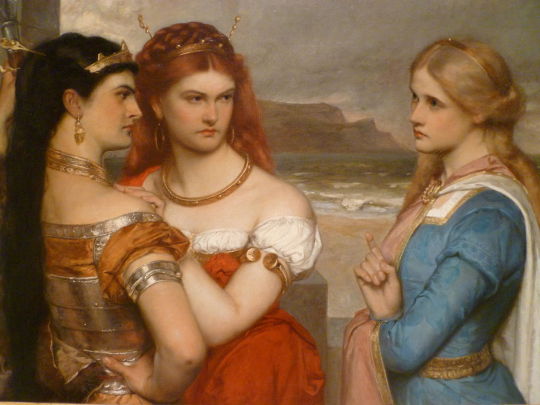
The Three daughters of King Lear by Gustav Pope. From left to right are Regan, Goneril, and Cordelia. Image retrieved from King Lear on Wikipedia.
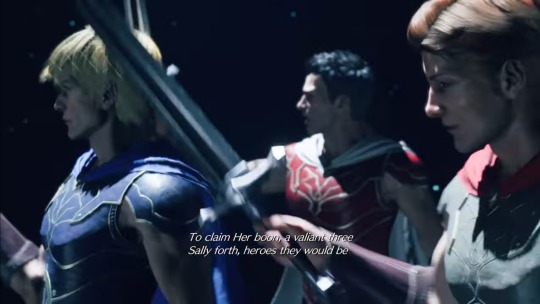
The three would-be heroes of Loveless raising their swords. Of the three, only Alphreid on the left is given explicit name, but parallels between the three and other characters within and without the Compilation may be drawn.
While there is a "mother goddess" in the mix, understanding it here without a background understanding of possible precursors (like Campbell's mother goddess or the Guanyin of Chinese/Japanese Buddhism from which he derived it, in part) would only serve to make this longer in explanation. As it goes, she is one of the primary features of the play which connect Loveless to Final Fantasy VII as a whole, but understanding the reason for her inclusion is impossible without looking at FF7 as a whole. As it stands, Loveless can be understood as a work in its own right in a similar way to how Hamlet's play can be understood as a character in the play rehearsing his own mode. That is; Loveless is informative even without understanding Remake and Rebirth in whole.
Already, though, we see that we've reached the point of tragedy of King Lear: it is not long after the imprisonment of Cordelia that she is hanged and her father dies of grief and madness. The Fool, though, appears to deliver the reveal of Bloomian clinamen, the swerving away an author (or authors) makes from the precursors when they create their own misprison (work of art/poetry/literature/etc).
Where King Lear ends shortly after Cordelia's imprisonment, Loveless only truly begins there, and the Fool, a character used to communicate the true nature of things, appears. It is fitting, then, that the character who communicates the true nature of things appears again here as the only character without change or loss in title, being the Fool in both King Lear and Loveless. He introduces us to Alphreid, who himself calls back to the madness of loveless Shakespearean tragedies with his "To proceed... or not to proceed!" line after the tutorial.

Cloud as Alphreid putting on his theater shoes and reminding the reader of the question.
Where Hamlet and Cordelia are condemned to tragedy because of their rejection of love or the rejection of their love, though, Alphreid is freed and empowered by his newfound acceptance of the Goddess' love through the hand of Rosa. This reveals the tessera of the work, the fragment that can be used with other fragments of the work to show where the author (or authors) suggest that the precursors did not go far enough. Hamlet and King Lear, then, are filled with nothing but villains and victims who refuse to embrace the power of love of all things. This makes sense, as those were tragedies.
This blends with the daemonization the work employs, a Counter-Sublime in reaction to the Sublime of the precursors. This is the evidencing of the tessera from before in the way even nature, thundering with Alphreid's rally, reveals in Loveless the counter to the Shakespearean idea that lovelessness flattens all. Where Cordelia and Ophelia die to lack of true love from even one person, Alphreid becomes empowered by love for all things. This reflects even in the reader's/player's ability to progress no matter who they declare their love for among Varvados, Garm, and Rosa, as love conquers all and lack of love flattens. Garm and Varvados, who refuse love, can be expected to fail as long as the player continues.
In hand with the application of the daemonization employed is the kenosis, the breaking device used by an author (or authors) to empty their own work and that of the precursors of their nature as literature. Here, the authors remind the reader that they are playing a game by forcing them to interact to continue Alphreid's story, breaking the illusion of the game's reality while highlighting that Hamlet and King Lear can be put on the shelf as well if you don't wish to continue. Yet, the reader does.
And, when they do, they find revealed in it the reality of the second-to-last revisionary ratio of the anxiety of influence, askesis, the movement stressing the individuality of the author (or authors). They find it most clearly in the Fool of Loveless, pleading with the audience in soliloquy where he calls upon central, humanizing lines of Shakespeare's Julius Caesar, Romeo and Juliet, and Troilus and Cresside to humanize the creators of his misprison and the misprisons embodied in its precursors,
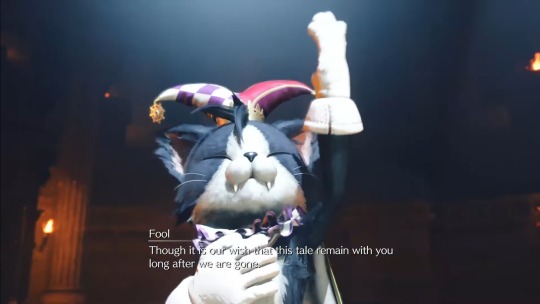
Cait Sith as the Fool doing his best to evoke pathos for the reader through allusion to the end of things.
Friends, lend me your ears. (Shakespeare, Julius Caesar) Our inspiring hero's and indomitable princess's tale draws to a close. Only one act remains. Parting is indeed such sweet sorrow. (Shakespeare, Romeo and Juliet) But as they say, all good things must come to an end. (Chaucer/Shakespeare, Trolius and Criseyde/Troilus and Cressida) Though it is our wish that this tale remain with you long after we are gone.
Emphasis and parenthetical additions mine.
Almost in those words, the Fool draws the reader of both King Lear and Loveless to consider the work as its own unique and novel expression; though, the Fool of King Lear simply tasks the reader with recognizing the application of Lear's lessons. The Fool of Loveless, however, calls on the reader to keep the work as a novel piece with them even as they finish the work.
Even more, it seems to remind the reader that an end in death is soon to come, for Mark Antony was lamenting the death of Caesar in his "Friends, Romans, countrymen, lend me your ears..." speech, Juliet was foreshadowing in a good night that her cherishing might kill Romeo when she described parting as sorrow and grief, and Chaucer was describing the parting of Criseyde despite the pleas of Troilus when he said, "every thing hath ende" (which Shakespeare later modified). For all of these works, the Fool seems to be showing the ways in which this story will show an end isn't quite so simple - that a death isn't so simple as ending everything for those who survive.
The last of the revisionary ratios of the anxiety of influence, the opening of the work near the end of the author's (or authors') life that reveals the precursors' influence which is apohprades, is evident across the work in the blatant allusions we just discussed and in the name of the trilogy of works that contains it: Remake.
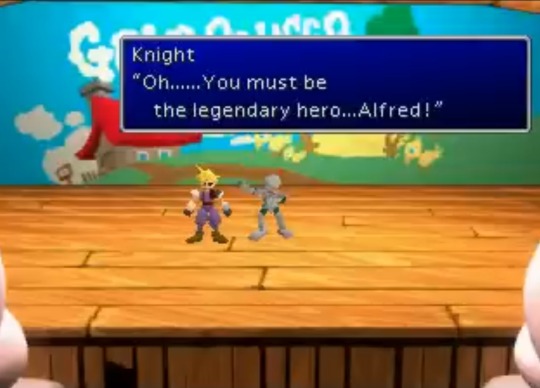
Cloud putting on his standoffish act as Alfred. The translation has served to better the depth, as even Alphreid is the portmanteau of Siegfried and Alberich from The Ring Cycle, highlighting Cloud's dualism.
As the creators of the 1997 release age and face death's tyranny, the anxiety of influence begets renewed misprison that causes the authors to reveal the precursors to their work with their reactions to them. Isolated to just Loveless, a reader can see a return of Shakespeare into a work that originally copied the format he used without clearly showing his presence to reveal a new reading of his most prominent tragedies. This reading, even, mirrors that of Bloom's reading of To Kill a Mockingbird: the tragedies of Shakespeare were preventable or survivable for more of the characters with the same force that could have prevented the crisis of To Kill a Mockingbird.
Why Does This Matter?
Because the curtains don't have to be blue if they mean something to you or the person that made them, and finding meaning in even just a small part of a work can reveal meaning to you in the whole and in other things you enjoy. If we can see Loveless as a take on growth through love of all things and people in the face of oppression influenced by a myriad precursors through baby's first Bloomian lens, we can do that with the Remake trilogy as a whole, even before it is completed. That, even, is just one critical lens that can be used. Jacob Geller has a critique of Midgar as presented in Remake through the lens of architecture and an Akira Kurosawa film that leans towards Class/Marxist Criticism, for example.
I know this was long, but I am rather determined to help people understand that the literacy skills and canons their teachers tried to impart on them are useful outside of reading those same canonical works. Final Fantasy VII suffers from surface-level readings (as opposed to something like Silent Hill or Outer Wilds), but we don't have to read any work like that, especially if we can evidence more deep readings with the text.
So, thanks if you read this far; though, you probably didn't need me to tell you about this stuff if you did.
If you're interested in the Xiyouji thing, it isn't my bigger project, but I'm gonna be semi-regularly posting readings of characters, locations, fiends, concepts, and events as seen in Remake and Rebirth through the lens of adapting Xiyouji. I'll probably be posting Barret Wallace as Sandy first, but it is a tossup between Red XIII as Red Boy, the Trio as the Three from Gensomaden Saiyuki, or The Crow's Nest's Colin as the Crow's Nest Zen Master after that. I wanted to start with this to demonstrate the idea in a smaller part and remind people why they were taught media literacy in school, though. The The Norse Myths That Inspired Final Fantasy VII guy, M.J. Gallagher, seems to be trying to do that in a way, too, but he went a different direction from Dragon Quest and the king of Xiyouji adaptations that come from Japan who helped make it - Akira Toriyama, the creator of Dragon Ball.
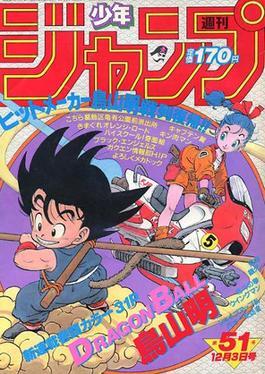
The first appearance of Goku by Akira Toriyama also beginning his journey as an adapted Monkey on a cloud towards becoming the Buddha Victorious in Strife. Image retrieved from Goku on Wikipedia.
#ff7#ffvii rebirth#ff7 loveless#ffvii remake#final fantasy 7#cloud ff7#ffvii#loveless#shakespeare#final fantasy rebirth#final fantasy vii rebirth#final fantasy vii#cloud strife#video game analysis#bloomian#harold bloom#literary criticism#new historicism#the anxiety of influence#bloomian critique#kenosis#askesis#apophrades#tessera#clinamen#daemonization#revisionary ratios#six revisionary ratios
3 notes
·
View notes
Text
About the 'Roald Dahl edits'
Can someone please just show me an actual, undoctored picture of the changes being made to which books?
That's all I ask! I keep seeing absurd clearly liberal-mocking fake scans that no book company would ever make being presented as "evidence" of the changes. Don't do that. Show me a list of the changes.
Welp, I'm writing about this because, as I've expressed before, I love Roald Dahl as a writer but I don't like him as a person. That's the thing about some people's work- it just comes with the territory that they are at LEAST 'problematic' given the creators worldview; Dahl, Lovecraft, Tezuka, Uncle Walt, even my German-crabapple daddy Ted Geisel. I'm not gonna @ these dead ppl for DARING to not be up to my modern liberal standards no more than I am gonna paint them as REAL LIBERATORS bcuz I want them to be -! When it comes to removing books from circulation or editing out words, I understand.
Regarding the changes though...I really haven't seen anything that's too wild?? Yet.
As a brief aside, I think it'd be better for everyone if The Witches was just removed from publication. It's Dahl's most offensive book when you combine it with his real world politics. And again I say screw the accusations that this book is 'sexist' when the problem with it is that it's antisemetic and so was Dahl.
But honestly? Changing the line to be "some ladies do wear wigs and there's nothing wrong with that" works with Dahl's writing style. Same with calling Augustus Gloop 'enormous'. Same effect in place, just without the sting of just calling a child fat.
Now, if these lines are left in place while Luke's grandma's explaining in the text how "no, don't pick at people's hair even if they're wearing gloves they aren't all witches" are given the boot, I can understand some outrage. But, again, to me I think this is better proof as to why Witches should just be left alone and maybe not published anymore. The og text did provide context, the problem is that the book itself is racist by asserting that all witches are 'evil', and that the only reason to not bother women with wigs and gloves is they "may not be a witch". That's messed up, even if it weren't alluding to any real life antisemetic-isms. Asideaside-- I'd be very curious to see how the The Twits is changed if it's changed at all. Twits has this very poignant description of how, no matter how unconventional you are, you can never be 'ugly' if you are good and sweet- where no matter how "pretty" you are, if you are an ugly person inside people will see you that way. It's a really good breakdown of that phenomena even though it's still technically bodyshaming. Also, they're monkeys, not people (take that as you will) but The Twits is about an abused family of stolen monkeys and birds tricking the Twits, who are their captors, into killing themselves and then returning to the wild where they belong. --- Anyway...removing the part of BFG where the giants says humans of different country's taste different or Mr. Grasshopper's awful quip about Mexicans in James and the Giant Peach isn't any skin off my nose. Especially if they are going to read to young kids today, kids don't need to hear that kind of language. Philly Pullman can disagree with me all he wants but personally I think these books, not their author's squeaky image or politics, deserve to live on.
That being said-
I would be upset if changes were made that started insisting that characters who were fat AREN'T fat, now. Or that the white cis cast Dahl wrote were now being described as bipoc or genderfluid when they weren't. Let's not pull a JK Rowling here. Yes, it is true that for Charlie and the Chocolate Factory Roald both a) wanted Charlie and the Buckets to be a black-British family and b) removed racist descriptions of the Oompa Loompas within his lifetime from real life pygmies to a fantasy-race. That's awfully neat of him for someone so much of turdwhich. Those kinds of changes are best for adaptations and reinventions of the stories. But it'd be indecent of the publishers to suddenly push the idea that the Buckets are black and always have been now, and/or that the Oompa Loompas can't still be racist somewhat just because they aren't depicting a real life ethnic group. To alter the original text of the books well after Dahl's death to be more 'friendly' IS the kind of censorship and historical revisionism to be wary of.
It's there that Pullman's comments of 'read another book' ring true: If you can't take that the book has some problematicisms in it, I tell you there are other children's books to read! By making the text of the books 'progressive by modern audiences' standards, that'd be erasing this very discussion and, more importantly, the concerns of BIPOC/Jewish people everywhere.
That'd be like if Disney rereleased Fantasia and had a redesigned, less offensive Sunflower in the background. That'd be disgusting, not because Sunflower shouldn't be reclaimed or redesigned, but because that's a company wanting to hide from the mistakes of the past in order to sell more stuff to you and make you trust them. I'd love me a black Charlie Bucket, but in a new version of Chocolate Factory, not an attempt to hide liberals from the fact that uncle Dahl was racist.
That's what I think should be continued, both as a way to keep his work alive and also to diss Dahl from beyond the grave: adapt his works!!!
Fantastic Mr. Fox, Matilda, James and the Giant Peach, BFG, and Willy Wonka are awesome. Dahl hated changes to his stories being made for film....so change his stories for film! Some things have to change and should change. While the 2020 Netflix The Witches was bad, I could get on board making Luke and the humans in the story people of color. That has the potential to turn the connotations of the original on it's head; instead of witches being a metaphor for 'secret societies' they'd be an illusion to real life organizations that tout themselves as kind and homely and traditional but are actually pure evil. How the witches specifically target children of certain demographics only for the dog to bite back and fight them with their own medicine- also keep the nice witch from the 80s film.
None of these changes would ever fix the fact that the og book is what it is, but they're an example of why adaptation, not revisionism, is so important.
Don't hide from mistakes of the past. That's why I'm as upfront with you all about my inspiration for my works being Dahl and Dr. Seuss. These people are not perfect and they're also not my own essence of creativity- but you can believe I was inspired to write because of them. Dana Terrace absolutely has Harry Potter to thank for The Owl House-it doesn't mean Owl House should pay for Harry Potter's sins. Let Owl House pay for it's own sins, thank you!
When it comes to problematic/ offensive work of the past, we should not be hiding from them. Teach kids and adults to think critically and learn that their white-made nostalgia is biased and bad sometimes. When it comes to problematic/ offensive works by still living authors, please just don't by Hogwarts Legacy.
That's all I got. Feel welcome to @ or message me if there's something my white-Gentile-ness forgot or am leaving out. I want to have an actual conversation about this cuz I think it's important. This post also kept me from falling asleep midday again.
#roald dahl#the witches roald dahl#the witches#james and the giant peach#charlie and the chocolate factory#fantastic mr fox#matilda the musical#matilda roald dahl#Roald Dahl's edits#Roald Dahl's classics#Roald Dahl revisions#revisionist history#historical revisionism
20 notes
·
View notes
Note
Hello!!! Your recent ID post has def helped me a lot and I'm slowly adding alt text to past work (and then eventually reblog with IDs in desc :D). However there are some things that I'm still uncertain about:
1) How should someone properly format ID's where you have multiple images that you don't want to/can't separate with IDs (i.e. comics). I'm sorry if I missed an example of that in one of the linked sources ^^;
2) Additionally, as someone with hand/wrist issues I'm really grateful for shortened posts/read mores as it's less strain for my hands to scroll past. That is to say, would it still be rude to place an ID in a read more if the IDs happen to be lengthy (in the event of describing multiple images)? Would it be better to add it as a reblog instead?
I would like to try to make my posts more accessible for others!!! I'm incredibly grateful for those who provide audio captions, so I am very interested in doing the same for visual descriptions :D thank you for bringing attention to this, and providing helpful resources on the topic as well ^w^♡
I'd like to mention there's a Tumblr feature that automatically shortens long posts. Go to Settings -> Dashboard -> Interface --> Shorten long posts.
Hi besties! Also don't worry. There are a lot of links I gave you guys, and even I get lost in the sauce. The most useful thing I found writing IDs for comics is this:
it's for all types of visual media, but it has a comic section. The general formatting is this:
Write comics in a single ID:
Have an introductory paragraph where you describe the context of your comic, or the context of its beginning. This includes your style, the main subjects and how they're positioned, the surroundings (the location), and the basic thing happening between the characters.
Then the later paragraphs will go into specifics of dialogue and action. If there's a visual change, such as a zoom-in or a change of perspective, you're going to describe that, and put that before the dialogue.
End ID
Panel by panel is not good. Comics are narratives and stories and they need a flow. This post talks about it here:
Also, often, describing a comic isn't that long. Unless you're posting multiple full-blown pages at a time, then your typical 4-panel or maybe, 1-2 page comic will span a few paragraphs for the ID. But I answered an anon over at @lab-labrava about comic lengths. If it genuinely is long then @antimonarchy addressed this problem
Put image descriptions first. Don’t hide them under readmores or any other text. If you have something with multiple images and you are the creator, place the description under each image in succession rather than all at the end. Readmores are ableist, as they require someone who has vision problems/one of the conditions described above to do more work to access the message of visual content.
^^^ This goes more in depth. Check the section with Placement of ID
You guys see me writing IDs in reblogs like this:
ID:
Image 1: (description of image)
Image 2: (description of image)
End ID
This is because I'm reblogging from the OP. I don't own the original post, so I'm forced to format it like this when ideally, I'd place the ID straight after each image. if you have multiple images, then write an ID for each image and place it straight after that image, like the following:
(image 1)
ID: (description of image 1) end Id
(image 2)
ID: (description of image 2) end ID
and so on.
Full-Blown Comics with Multiple Images/Pages
See I'm so conflicted here. When it's a huge ongoing project, then the ID for each page can span multiple paragraphs, and each Tumblr post may have multiple comic pages in a single update. So my formula above, where I place an ID straight after each image can elongate the post severely. In that case, alt text is a good idea. Especially since people using screen-readers may listen to Image image image, and skip past the post, not waiting the lump-sum ID near the end. In this case, you can forgo ID and write alt text. That's what most people do anyways.
I hope that answers some questions
5 notes
·
View notes
Note
Excuse me!! I don't want to bother...
I've been following this blog for a time and I'm really grateful for all the resources/researches you provide! I've been looking everywhere for more information about how the kenjutsu schools functioned around the middle-Edo era. I know there were many schools of different styles/teachings since there wasn't war anymore but I can't find more information about how they functioned daily, and the daily life of the students, their dynamic, if they had any other actives besides training (most media seems to focus only on this).... Most of the information available seems to be by the early beginning and end of Edo period/begining of Meiji and not focused on this aspect of living :( do u know where can I find more information about this? I have a few questions too if it's not bothering I can send them in another ask! Thank you :')
Thank you so much for reading my tumblr! <3
---
Unfortunately, that's a difficult question for me to answer.
Although much has been written about sword schools in the Edo period, texts often focus on specific aspects, such as the school's lineage or its relationship to philosophical teachings, or the changes in equipment and practices taking place, and little seems devoted to the daily functioning of a dojo - at least in the texts I've come across.
So while I can and certainly will try to share information I've learned over the years, this post may not be able to fully answer your questions about daily functioning and student lives - but hopefully you will get some useful information from it nonetheless.
Hopefully this can also become a group effort: if anyone has more specific information, please reblog this post and add to it. I can also post the question on Twitter - my Twitter followers have helped me find information and book recommendations on more esoteric subjects before, so it's worth a try.
Image: two boys practicing with wooden swords (~ Meiji period).

A language note at the beginning:
The term dojo as we use it today to mean "a place for practicing martial arts" isn't used in this context until the Meiji period.
Previously the most common term was keikojo (practice hall). In translated period texts and modern media, you might see the terms fencing hall or training hall used as the English equivalent.
I will use dojo in this post because it's the word currently in use, but just be aware of dojo not being the most correct term if you write historical fiction or create manga set prior to the Meiji period.
___
Historically speaking, the mental image most of us have of a proper kenjutsu dojo first appears in this form during the Edo period: a building set up specifically for the teaching and practice of swordsmanship.
But prior to the Edo period, the concept of a dedicated space for sword practice wasn't a given: most training took place outdoors.
Once training started moving to indoor spaces built or modified for this purpose, these were at first commonly equipped with tatami mats until it became fashionable for training halls to have wooden plank flooring, something that appears to have happened around the mid- to late 1600s.
A large, well-established dojo still featured a raised tatami platform at one end of the hall for the soke, the master of the school, to sit and supervise training. A small dojo, meanwhile, wouldn't have this feature and its soke would be more likely to actively lead the training.
At any rate, we still see much variety in the training halls of the Edo period: while there were certainly "proper" dojos as we think of them today, with high ceilings, polished wooden floors, a shrine located in a place of honor (commonly to Takemikazuchi-no-Okami, one of the patron deities of martial arts), and students' name plaques arranged by rank, there were as many schools that made due with perhaps less-than-suitable buildings or that trained outdoors.
There are still traditional schools (koryu) today that use their dojo primarily for important and formal occasions, such as competitions with other schools and ceremonies, rather than for regular training.
Image below: Iaijutsu (sword-drawing) practice in a tatami room (~1690).

Changes to Swordsmanship in the Edo Period
An overall shift in the practice of swordsmanship occurs in the Edo period: away from the previous focus as a battlefield necessity and toward the sword as both martial art and spiritual practice.
This takes place because the Edo period was a long period of peace (about 250 years) following centuries of warfare, and the martial prowess of individual samurai is no longer at the forefront.
Traditionally, a young samurai's martial education did not just include swordsmanship.
Although this was an important skill, the sword was only a small portion of his education in the martial arts, which also included archery, gunnery, the use of long weapons such as spear or naginata, unarmed combat, horseback riding, swimming, and military theory, including tactics and strategy. Depending on where he was educated, he might also learn other arts, such as hojojutsu or the use of shuriken or kusarigama.
Because swordsmanship in the Edo period is no longer used on the battlefield, the focus moves away from fighting an opponent wearing armor, which leads to changing techniques in many schools since an opponent wearing kimono and hakama can be cut in many more places than an opponent wearing armor.
For this same reason, training also shifts away from the use of other weapons and focuses primarily on sword techniques.
While in the past, a samurai's primary weapon may have been the naginata, especially when fighting from horseback, and he would have drawn his sword only if he dismounted and/or his primary weapon was lost, his swords now are the only weapons he carries.
That is not to say sword schools in the Edo period exclusively taught swordsmanship. Most would have taught a curriculum focused primarily on swordsmanship but also included unarmed combat and one or more other weapons. Even today, many sword schools still teach more than just sword techniques.
---
Introduction of a Spiritual Focus
One interesting thing happening at the very beginning of the Edo period is that swordsmanship becomes more focused on the mental training and spiritual aspects of practice.
This is due to the country's shift toward neo-Confucianism, which is adopted by Tokugawa Ieyasu as the shogunate's secular belief system and builds the foundation of all aspects of governing and running (controlling) Edo society.
Side note: If you're interested in a samurai education of your own, start with the Four Books and Five Classics. You will find these referenced frequently in period dramas.
Here is a really brief explanation of how Confucianism relates to Japanese martial arts practice, a subject that has not been explored in great depth by scholars. Many of the practices we associate with Japanese martial arts today, such as perfecting kata (forms) and bowing before and after practice originate from this introduction of Confucianism.
On that note, one of the reasons the Hokushin Itto-ryu so quickly rose to prominence after Chiba Shusaku founded it in the 1820s was that it did away with the philosophical underpinnings and religious terms used in swordsmanship and simplified both terminology and techniques. (The other reason was, of course, that simplifying techniques meant students progressed more quickly: I believe the actual quote I read was that you could "master in one year what took three years to learn in other styles.")
---
Changing Equipment
Because the overall focus and individual techniques changed during the Edo period, it shouldn't come as a surprise that equipment followed suit.
Throughout the Edo period, schools used many different types of wooden and bamboo swords for practice, and these varied widely in material, length, and weight.
One of the earliest uses of a bamboo sword was the Yagyu Shinkage-ryu's fukuro-shinai, a bamboo sword covered in leather.
At a time when protective equipment was not worn during sparring, this padded practice sword allowed individuals to strike each other rather than having to halt their strikes before impact, as they would have done with a wooden sword. (Remember: a wooden sword can still injure or even kill a person.)
Other types of shinai (bamboo swords) that would look familiar to modern Kendo practitioners started being used in the 1700s, but it wasn't until 1855 that unified regulations were introduced to specify the material, length and weight - regulations that still largely determine the specs of modern Kendo equipment, by the way.
Practice armor was first introduced in the early 1700s as a way to increase safety during full-contact sparring, and by the 1760s, available equipment was similar to what is worn in Kendo today: a torso protector (do) made from bamboo and leather, gauntlets (kote) to protect the hands and forearms, a belt with flaps (tare) that protect the groin and thighs, and armor that covers the head (men).
However, practice armor was not used by all schools and sometimes individual parts used varied between styles. For example, some schools did not teach strikes to the torso because their techniques were based on the armored combat of the Sengoku period, so it would have been considered pointless to protect the torso in practice since you shouldn't be striking it in the first place.
Practice armor became the norm when sword schools were once again allowed to hold practice matches and competitions against schools of other styles, something that had been outlawed by the shogunate at the end of the 1600s because of concerns it would lead to conflict, and then allowed again at the beginning of the 1800s.
---
Swordsmanship as a Business
Lastly, one of the largest changes that occurred was that sword training became available not only to members of the samurai class but also to farmers, tradesmen, and townsmen by the mid-Edo period.
Although only samurai were allowed to carry two live swords, anyone could learn swordsmanship at the fencing hall.
The biggest reason behind this shift was that the teaching of swordsmanship became a business and many new schools opened: estimates suggest between 500 and 700 schools existed in the mid-Edo period. Having so many schools and styles of swordsmanship meant there was a great need to find students to fill them so they were actually viable for the owner and his instructors.
Because a sword school could be opened by anyone who held a license (menkyo kaiden) - meaning, they had mastered all of the techniques of their sword style and had been licensed to teach them - opening a dojo was sometimes a way for a ronin to make money if he couldn't find a position as sword instructor with an established samurai clan.
Additionally, it wasn't uncommon for a samurai to start his own sword school by modifying the style in which he was licensed and founding his own by adding techniques he had invented.
Oishi Susumu, for example, was licensed in the Yagyu Shinkage-ryu but founded his own style, Oishi Shinkage-ryu, in the 1830s after becoming well-known throughout Edo because he won a lot of matches against other schools using a left-handed technique. (You previously read about him here.)
On a side note, there was at least one school in the early Edo period (around the 1650s) owned and run by a woman, Sasaki Rui, but many schools did not accept women at all. (Ironically, they didn't allow women for the same reason women are not allowed in the sumo ring today - under traditional Buddhist and Shinto beliefs, they're considered "impure" because of menstruation.)
Speaking of swordsmanship as a business, one might wonder how a dojo supported itself to maintain its buildings and grounds and pay salaries to its owner and teachers.
In the Edo period, most dojos earned very little money from their students and instead relied primarily on supporters: individual samurai or samurai clans, large merchants and wealthy farmers who were interested in martial arts generally provided most of the funding for public dojos.
Students themselves usually paid a registration fee (sokushu) in the form of goods such as brushes, paper, and ink, in addition to a monthly tuition (gessha) based on the student's social status and economic situation rather than a flat fee. In rural areas where a dojo's students were primarily farmers and peasants, those fees were often paid in goods, such as food and sake.
Additional income could be earned when the soke or his instructors traveled to teach outside of their own dojo. For example, when Kondo Isami traveled to teach in Tama, he was paid 2 shu (500 mon) per student. His assistant instructors, like Okita Soji, earned 1/2 shu (125 mon) per student. (Please tell me if my math is wrong.)
Lastly, many samurai who opened a dojo of their own already had another income: if they were hatamoto or retainers of a clan, for example, they would receive a stipend. While this also meant they already had a job, a samurai's working schedule was generally one day at work followed by two days off, leaving more than enough time to run a dojo.
Images: (left) Takasugi Shinsaku wearing practice armor (~ 1860s); ukiyo-e print of sword practice by Toyohara Chikanobu (~ early Meiji).


Practice Attendance
For most students, the fencing hall was where they went for practice every few days - much like martial artists today go to their dojo a few times each week but pursue their education or work and other hobbies on the days in between.
Clan Schools
For young samurai enrolled in their clan school, however, training at the dojo could be an everyday or every-other-day affair that was part of their overall education.
Although the curriculum and requirements varied between clans, young samurai usually started attending clan schools around age 8 and finished their education between the ages of 15 and 20. Many of these schools had their own dojos, but some instead sent students to a nearby dojo for instruction.
On a side note: Some clan schools required students to attain a specific level of proficiency in swordsmanship (and, of course, their other learning) before they could graduate. Failing to do so could mean they'd be barred from becoming head of the family, taking over a hereditary post, or being limited to a lower salary.
Live-In Students
Live-in students (uchi-deshi) were commonly accepted at dojos during the Edo period and they lived, trained, and worked at their sword school full time, not unlike today's sumo wrestlers who live, eat, sleep, and practice at their sumo stable in Japan.
Uchi-deshi at sword schools sometimes started as very young apprentices aged barely 10 or 11 years old if they had talent but couldn't, for one reason or another, simply attend as students while living outside the school. While that sounds very young to us today, it wouldn't have been an unusual age for a boy in the Edo period to become a page or start apprenticing with a merchant or craftsman.
However, uchi-deshi weren't always young apprentices. A live-in student could be an adult assistant instructor working toward their full license, or they might be an older teenager the current soke intended to adopt once the boy came of age, too.
Live-in students usually had rooms either in the dojo itself or in the soke's home, the latter especially if it was located next to or very close to the training hall. They were expected to work for the soke in return for their room, board, and training, and their work could include any of the chores that needed to be done in the soke's home and the training hall, including: cleaning, sweeping floors and porches, maintaining and cleaning equipment, making repairs, tending to the yard, running errands, taking care of clerical duties, and, once they had reached the necessary level in their own training, supervising the training of other students and giving instruction.
Treatment of uchi-deshi varied. A live-in student who was particularly talented and might be considered as the next soke, or potentially to be adopted by the current soke, might be treated like family. Other times, a live-in student might receive a small wage for his work in addition to his room and board, especially if he became an assistant instructor. And in other instances, a live-in student might be treated more like a servant.
Image: Samurai and a sword school sign, Suzuki Kinsen (~1900).

A Day at the Dojo
One of the very few references I've found that describe an day at the fencing hall for (presumably) live-in students said they practiced prior to breakfast, ate breakfast together, and then practiced until around midday before taking a break.
While it didn't go on to describe the remaining day, the passage reminded me of what I've read about the way sumo wrestlers train today, and I wonder how much of a modern sumo stable's routine is based on traditional routines of martial arts dojos of the Edo period, or (at any rate) on sumo stables of the Edo period whose traditions and routines may originally have been fashioned after other types of martial arts schools.
In the absence of concrete proof, those similarities are simply conjecture, but you can read about daily life in a sumo stable here if you think that line of inquiry might be helpful.
However, even if they are similar, I think the schedule would apply only to live-in students. Based on other sources that mention samurai attending lessons at their sword schools, it doesn't sound like they would have been there for practice prior to breakfast or that they would have trained for a large portion of the day.
Outside Activities
I haven't been able to find a whole lot of information about dojo students engaging in outside activities as a group, although there are some mentions of group outings - for example for cherry-blossom viewing in the spring and having a bento picnic after training in a different outdoor location in the summer - so it appears that at least some dojos offered more to their students than just training.
I would think (again, conjecture) that it would have been similar to modern-day martial arts schools, which might host a training camp for its members, have members travel for a friendly match with another school or to give a demonstration, or get together for a holiday party or some other event.
Images: Practice with wooden swords and other martial arts, Hokusai (~ 1800s).


#ronin answers#kenjutsu dojos#swordsmanship#swordsmanship in the edo period#history notes#historical notes#history research#historical research#history reference#historical reference
18 notes
·
View notes
Text
let's talk about andi mack's worldbuilding
sorry this took forever to make! i've been pretty busy with school stuff and i kind of lost my inspiration for a bit, but i ultimately really enjoyed writing it! i wish i could've included more pics (tumblr has a max of 10 per post), and it kinda turned from less of a mini analysis to more of an extremely long rant... but i hope it's still a fun read!
i've been rewatching the show over the past few weeks (thanks again to @disneymack for the link!), and i’ve been noticing a lot that i never did the first time around. this is really the first time i’ve watched the show from start to finish since it aired, and it honestly feels so different this time - probably a combination of the fact that i’m not as focused on plot and can appreciate the show as a whole, and also that the fandom is much, much smaller now, so there’s a lot less noise. so the way i’m consuming this show feels super different than it did the first time, but the show itself doesn’t - it’s just as warm and comforting to me as it was the first time around, if not more so.
i think a lot of that can be attributed to andi mack’s “worldbuilding”. i’m not quite sure that this is the right word in this context, to be honest, because i mostly see it used in reference to fantasy and sci-fi universes, but it just sort of feels right to me for andi mack, because you can really tell how much love and care went into constructing this universe. for clarity, worldbuilding is “the process of creating an imaginary world” in its simplest sense. there’s two main types: hard worldbuilding, which involves inventing entire universes, languages, people, cultures, places, foods, etc. from scratch (think “lord of the rings” or “dune”), and soft worldbuilding, in which the creators don’t explicitly state or explain much about the fictional universe, but rather let it’s nature reveal itself as the story progresses (think studio ghibli films). andi mack to me falls in the soft worldbuilding category. even though it takes place in a realistic fiction universe, there’s a lot of aspects to it that are inexplicably novel in really subtle ways.
so watching the show now, i’ve noticed that the worldbuilding comes primarily from two things - setting and props, and oftentimes the both of them in tandem (because a big part of setting in filmmaking does depend on the props placed in it!).
one of the most obvious examples is the spoon. it really is a sort of quintessential, tropic setting in that it's the main gang's "spot", which automatically gives it a warm and homey feel to it. and its set design only amplifies this:
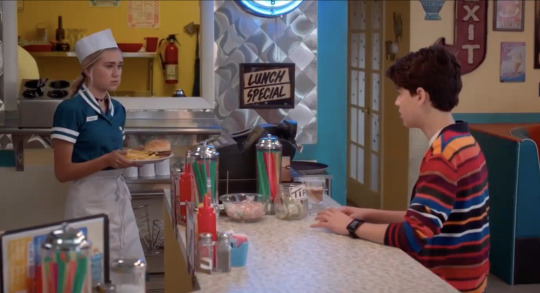
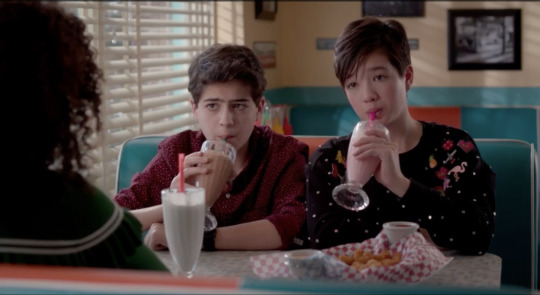
the choice to make it a very traditional 50s-style diner creates a very nostalgic, retro feel to it, which is something that's really consistent throughout the show, as you'll see. from the round stools at the bar, to the booths, to the staff uniforms, this is very obvious. the thing that i found especially interesting about it though is the choice of color. the typical 50s diner is outfitted with metallic surfaces and red accented furnishings, but the spoon is very distinctly not this.
instead, it's dressed in vibrant teal and orange, giving it a very fresh and modern take on a classic look. so it still maintains that feeling of being funky and retro, but that doesn't retract from the fact that the show is set distinctly in modern times.
of course, this could just be a one-off quirky set piece, but this idea of modernizing and novelizing "retro" things is a really common motif throughout the show. take red rooster records. i mean, it's a record shop - need i say more? it's obviously a very prominent store in shadyside, at least for the main characters, but there's no apparent reason why it is (until season 2 when bowie starts working there, and jonah starts performing there). a lot of the time, though, it functions solely as a record shop. vinyl obviously isn't the most practical or convenient way of listening to music, but it's had its resurgence in pop culture even in the real world, mostly due to its aesthetic value, so it's safe to say that it serves the same purpose in the andi mack universe.
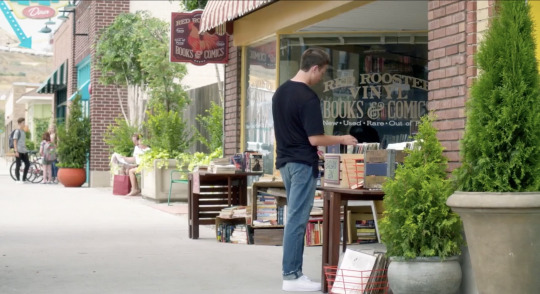
the fringe seems to be nostalgic of a different era, specifically the Y2K/early 2000s period (because it's meant to be bex's territory and symbolic of who she used to be, and its later transformation into cloud 10 is representative of her character arc, but that's beside the point). to be honest, exactly what this store was supposed to be always confused me. it was kind of a combination party store/clothing store/makeup store/beauty parlor? i think that's sort of the point of it though, it's supposed to feel very grunge-y and chaotic (within the confines of a relatively mellow-toned show, of course), and it's supposed to act as a sort of treasure chest of little curios that both make the place interesting and allow the characters to interact with it.
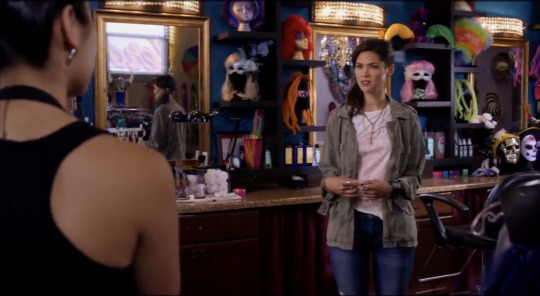
and, of course, there's andi shack. this is really the cherry on top of all of andi mack's sets, just because it's so distinctly andi. it serves such amazing narrative purpose for her (ex. the storyline where cece and ham were going to move - i really loved this because it highlights its place in the andi mack universe so well, and i'm a sucker for the paper cranes shot + i'm still salty that sadie's cranes didn't make it into the finale) and it's the perfect reflection of andi's character development because of how dynamic it is (the crafts and art supplies can get moved around or switched out, and there's always new creations visible).
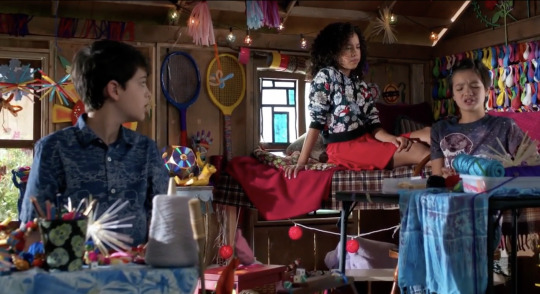
going back to the nostalgia motif though, the "shack" aspect of it always struck me as very treehouse-like. personally, whenever i think of treehouses, there's this very golden sheen of childhood about it, if that makes sense. i've always seen treehouses in media as a sort of shelter for characters' youthful innocence and idealistic memories. for example, the episode "up a tree" from good luck charlie, the episode "treehouse" from modern family, and "to all the boys 2" all use a treehouse setting as a device to explore the character's desire to hold onto their perfect image of their childhood (side note: this exact theme is actually explored in andi mack in the episode "perfect day 2.0"!). andi shack is no exception to this, but it harnesses this childhood idealism in the same way that it captures the nostalgia of the 50s in the spoon, or the early 2000s in the fringe. it's not some image of a distant past being reflected through that setting; it's very present, and very alive, because it reflects andi as she is in the given moment.
some honorable mentions of more one-off settings include the ferris wheel (from "the snorpion"), the alley art gallery (from "a walker to remember"), SAVA, the color factory (from "it's a dilemna"), and my personal favorite, the cake shop (from "that syncing feeling").
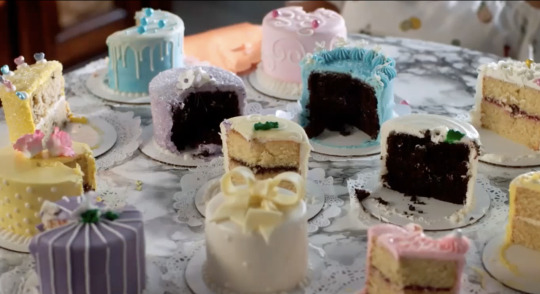
[every time i watch this episode i want to eat those cakes so bad]
these settings have less of a distinctly nostalgic feel (especially the color factory, which is a very late 2010s, instagram era setting), but they all definitely have an aura of perfection about them. andi mack is all about bright, colorful visuals, and these settings really play to that, making the andi mack universe seem really fun and inviting, and frankly very instagrammable (literally so, when it comes to the color factory!).
props, on the other hand, are probably a much less obvious tool of worldbuilding. they definitely take up less space in the frame and are generally not as noticeable (i'm sure i'll have missed a bunch that will be great examples, but i'm kind of coming up with all of this off the top of my head), but they really tie everything together.
for example, bex's box, bex's polaroid, and the old tv at the mack apartment (the tv is usually only visible in the periphery of some shots, so you might not catch it at first glance) all complement that very retro aesthetic established through the settings (especially the polaroid and the tv, because there's really no good reason that the characters would otherwise be using these).
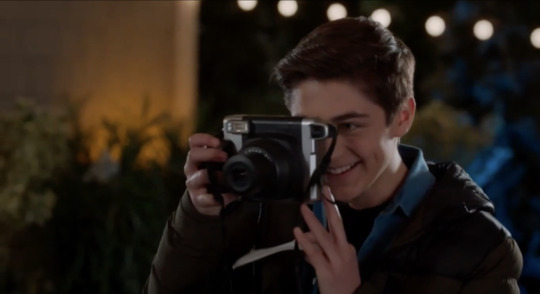
besides this, andi's artistic nature provides the perfect excuse for plenty of colorful, crafty props to amplify the visuals and the tone. obviously, as i discussed before, andi shack is the best example of this because it's filled with interesting props. but you also see bits of andi's (and other people's) crafts popping up throughout the show (ex. the tape on the fridge in the mack apartment, andi's and libby's headbands in "the new girls", walker's shoes, andi's phone case, and of course, the bracelet). not only does doing this really solidify this talent as an essential tenet of andi's character, but it also just makes the entirety of shadyside feel like an extension of andi shack. the whole town is a canvas for her crafts (or art, depending on how you want to look at it. i say it's both), and it immensely adds to shadyside's idealism. because who wouldn't want to live in a world made of andi mack's creations?

and, while it's not exactly a prop, the characters' wardrobe is undoubtedly a major influence on the show's worldbuilding. true to it's nature as a disney channel show, all of the characters are always dressed in exceptionally curated outfits of whatever the current trends are, making the show that much more visually appealing. i won't elaborate too much on this, because i could honestly write a whole other analysis on andi mack's fashion (my favorites are andi's and bex's outfits! and kudos to the costume designer(s) for creating such wonderful and in-character wardrobes!). but, i think it's a really really important aspect of how the show's universe is perceived, so it had to be touched upon.
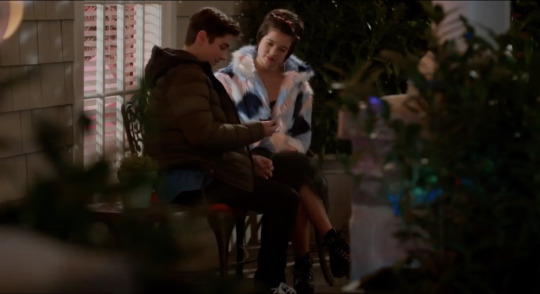
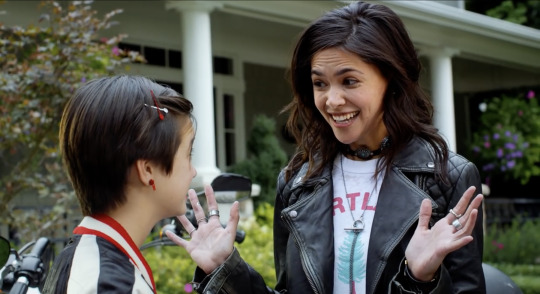
[^ some of my favorite outfits from the show! i am so obsessed with andi's jacket in the finale, and i aspire to be at bex's level of being a leather jacket bisexual]
and lastly, phones. this is a bit of an interesting case (pun intended), because the way they're used fluctuates a bit throughout the show, but i definitely noticed that at least in the first season terri minsky tried to avoid using them altogether. these efforts at distancing from modern tech really grounds the show in it's idealist, nostalgia-heavy roots, so even when the characters start using their phones more later in the show, they don't alter the viewer's impression of the andi mack universe very much.
so, what does all of this have to do with worldbuilding? in andi mack's case, because it's set in a realistic universe and not a fantasy one, a lot of what sets it apart from the real world comes down to tone. because, as much as this world is based on our own, it really does feel separate from it, like an alternate reality that's just slightly more perfect than ours, which makes all the difference. it's the idealism in color and composition in andi mack's settings that makes it so unmistakably andi mack. even the weather is always sunny and perfect (which is incredibly ironic because the town is called shadyside - yes, i am very proud of that observation).
the andi mack universe resides somewhere in this perfect medium that makes it feel like a small town in the middle of nowhere (almost like hill valley in 1955 from "back to the future"), but at the same time like an enclave within a big city (because of its proximity to so many modern, unique, and honestly very classy looking establishments). it is, essentially, an unattainable dream land that tricks you into believing it is attainable because it's just real enough.
all this to say, andi mack does an amazing job of creating of polished, perfect world for its characters. this is pretty common among disney channel and nickelodeon shows, but because most other shows tend to be filmed in a studio with three-wall sets, andi mack is really set apart from them in that it automatically feels more real and tangible. it has its quintessential recurring locations, but it has far more of them (most disney/nick shows usually only have 3-4 recurring settings), and it has a lot more one-off locations. it's also a lot more considerate when it comes to its props, so rather than the show just looking garish and aggressively trendy, it has a distinctive style that's actually appropriate to the characters and the story. overall this creates the effect of expanding the universe, making shadyside feel like it really is a part of a wider world, rather than an artificial bubble. it's idealism is, first and foremost, grounded in reality, and that provides a basis for its brilliant, creative, and relatable storytelling.
tl;dr: andi mack's sets and props give it a very retro and nostalgic tone which makes its whole universe seem super perfect and i want to live there so bad!!
#andi mack#buffy driscoll#cyrus goodman#jonah beck#tj kippen#tyrus#ambi#bex mack#analysis#film analysis#disney channel
94 notes
·
View notes
Note
I'd like to submit a review, but I have a trouble with writing image descriptions (I'm not a native English speaker & I make a lot of mistakes in English), can I still submit it? (writing reviews isn't that difficult to me though)
I really appreciate it when reviewers can write a description (or try to do so) as it gives me a little less work to do as I go through my inbox. For context, I’m now getting an average of eight asks a day. Folks will have noticed that I’ve got a great many asks I just haven’t gotten around to answering yet! So, even an attempt that gives me a base on which to work or develop helps me out, a lot.
Descriptions, at this point, aren’t a requirement for reviewers, but if you can write one or try to write one, I’d be grateful if you would.
I don’t want people to feel as though they can’t submit, especially for reasons of disability or language. Unfortunately, I’ve always got problems with the balance between folks who genuinely struggle with or cannot write a description and folks who just don’t think about it. (We’re all raised in an ableist world, and it’s easy to forget about being accessible on an axis that doesn’t concern us.) As a blogger with chronic hand pain, that puts me in a difficult situation. Getting six submissions in a row from folks who haven’t described (which has happened) can be pretty stressful when you’re running on a chronic spoon shortage. That hurts folks who have good reasons for not describing: people who can describe but don’t make it harder for me to leave that door open for those people who cannot describe and still wish to contribute (as they should be able to).
Submissions without descriptions might take some time to make it to our queue, as it depends on what’s in the inbox and where I need to allocate that day’s spoons. And if it arrives on a break day, it might take a few days longer still. I apologise for that, but limited spoons.
Conversely, grammar, punctuation, spelling and style isn’t a problem for me in submissions. Unless I’m having a very bad thumb day, I can do that with a mouse instead of both hands/typing, and with less thinking/concentration than that required of an image description. Editing submissions isn’t too difficult or time-consuming for me, so people shouldn’t worry too much on that end.
This is a guide for description writing that seems to work for this blog, and this is a loose guide to the sort of things to do or not do in a review submission.
I‘ll note that there are auto-generated image capture services, but they don’t provide descriptions/captures anywhere near the detail required. (That’s if they’re even correct.) Microsoft’s CaptionBot, for example, when I tested it, described a spinner as a mobile phone and two Tangle Jrs as a “large white ball”. Google has a version that requires training, but the example captions, while correct, have nothing of the detail we like to provide. Nor do I have the spoons to train it in describing something like stim toys!
(Note: I now ask sellers, vendors and crafters to provide image descriptions, and format their posts as per this guide. Anyone who’s looking to get promotion for a product they’re selling. This helps me get their products out to our followers more easily and quickly. This doesn’t apply to reviewers and informative posts about someone else’s item.)
Does that make sense? If you cannot describe, don’t and submit without one, but you’ll have all my gratitude if you try.
- Mod K.A.
7 notes
·
View notes